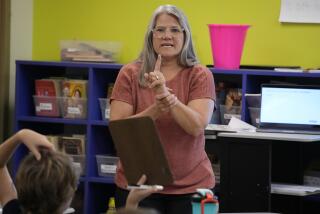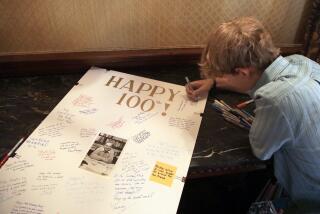Make Math Fun? No Problem : CSUF Honors Prof Whose Clever Methods, Enthusiasm All Add Up
- Share via
FULLERTON — To many students, math is like spinach. Sure, they know it’s good for them, but . . . yuck.
David L. Pagni has clever ways of changing that perception. For elementary school students, he has designed programs that use stories and songs, such as “The Twelve Days of Christmas,” to show how math can be fun in everyday life.
For high school and college students, Pagni encourages teaching that shows how calculators can be almost like hand-held game machines. For parents, Pagni created a program of “family math,” games that help fathers and mothers work out math problems with their children.
Pagni, a 52-year-old mathematics professor at Cal State Fullerton, is such an enthusiast about mathematics that even his office answering machine greets callers with a geometry question, suggesting that they ponder the problem while leaving a message.
Pagni believes math needlessly takes a bad rap.
“Math isn’t easy,” he said. “But it shouldn’t be drudgery.”
To make math easier both for teachers and students, Pagni has designed several major educational programs. In the process, he has won more than 30 grants totaling about $4.25 million in the 24 years he has been at Cal State Fullerton.
Now his university is honoring him: Pagni is currently reigning as “professor of the year” at Cal State Fullerton.
“Dr. Pagni fully deserves his standing among the nation’s foremost mathematics leaders,” said Cal State Fullerton President Milton A. Gordon. “He is a highly creative, energetic and caring professor whose model programs have benefited thousands.”
Kolf Jayaweera, dean of the School of Natural Science and Mathematics, said Pagni’s work with grade-school and high-school teachers and students has helped in “reducing math anxiety.”
Relieving that anxiety is something Pagni has been doing ever since his high school days in the small central California town of Sonora.
“When I was a senior in high school, I helped other students in their math classes,” he recalled in a recent interview. “It was somewhat of a revelation, I guess, and I decided I wanted to be a teacher.”
Pagni graduated from Sonora High in 1959. Four years later he had earned a bachelor’s degree in math from Cal State Chico. Then he became a high school teacher.
Pagni taught math at Amador High School in Sutter Creek in 1964 and 1965, and at Los Altos Intermediate School in Camarillo from 1966 to 1968. In 1968 he won a scholarship to Notre Dame University, where he earned his master’s degree.
In 1969 Pagni came to Cal State Fullerton, where he taught math while intermittently working on his doctorate in education. He completed his Ph.D. at the University of Wisconsin in 1972.
A bearded, wiry, energetic man, Pagni enjoys playing weekend softball and taking backpacking trips into the mountains. But whatever his conversation or activity, his world never seems far from the intricate and orderly universe of mathematics.
Santa Ana’s public schools have been the “labs” for much of Pagni’s research into better ways of teaching math. Santa Ana Unified School District officials invited him to work with their math teachers after hearing Pagni at a forum about six years ago, he said.
“That (invitation) was the seed that germinated into a grant from the National Science Foundation,” Pagni said. “The goals were threefold: to get teachers to relate better to students in terms of their delivery; to bring teachers up to date on new content in mathematics, and to bring in parent involvement through our program called ‘family math.’ ”
Santa Ana’s schools offer a particular challenge because so many students are not proficient in English, Pagni said. But the problem is also something of a solution, he added. “We should use mathematical content as a way of introducing language, and also we should find mathematics in language,” he said.
Mathematics in language? Pagni smiled at the question. “Children’s stories sometimes have things involving math,” he said. “The book ‘Charlotte’s Web’ is an example.”
Noting that the classic tale is about a spider that weaves intricate webs, Pagni said teachers can point out to children how the webs involve “geometric relationships and spatial visualization.
“In education lingo, we use the term integrative--using math across the curriculum,” he said. “For instance, if you’re teaching literature, you bring out how math is used in literature.”
More to Read
Sign up for Essential California
The most important California stories and recommendations in your inbox every morning.
You may occasionally receive promotional content from the Los Angeles Times.













